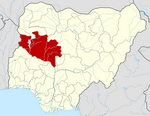Agwara
Kpacharka | |
|---|---|
LGA and town | |
| Nickname: AGR CITY | |
| Coordinates: 10°42′N 4°35′E / 10.700°N 4.583°E | |
| Country | |
| State | Niger State |
| Government | |
| • Local Government Chairman and the Head of the Local Government Council | Alh. Nura Mohammed |
| Area | |
| • Total | 1,538 km2 (594 sq mi) |
| Population (2006 census) | |
| • Total | 67,413 |
| Time zone | UTC+1 (WAT) |
| 3-digit postal code prefix | 923 |
| ISO 3166 code | NG.NI.AW |
 | |
Agwara (or Agwarra) is a Local Government Area in Niger State, Nigeria. Its headquarters are in the town of Agwara.
It has an area of 1,538 km2 and a population of 57,413 at the 2006 census.
The postal code of the area is 923.[1]
Climate
[edit]The climate is hot and oppressive, with a wet season that is overcast and partly cloudy, and a dry season that is partly cloudy.[2][3]
A daily maximum temperature of 97°F is typical during the 2.3-month hot season, which runs from February 24 to May 2. April has an average high temperature of 99°F and low temperature of 80°F, making it the hottest month of the year in Agwara.[4][2]
A daily high temperature below 88°F is typical during the 2.8-month cool season, which runs from July 3 to September 27. December, with an average low of 66°F and high of 90°F, is the coldest month of the year in Agwara.[2]
References
[edit]- ^ "Post Offices- with map of LGA". NIPOST. Archived from the original on 7 October 2009. Retrieved 2009-10-20.
- ^ a b c "Agwara Climate, Weather By Month, Average Temperature (Nigeria) - Weather Spark". weatherspark.com. Retrieved 2023-09-10.
- ^ "Weather Archive Agwara". meteoblue. Retrieved 2023-09-10.
- ^ "Monthly climate in Agwara, Niger, Nigeria". nomadseason.com. Retrieved 2023-09-27.
2.
By Bello Usman Gidi
By Lukman Umar Atako


Well, that’s interesting to know that Psilotum nudum are known as whisk ferns. Psilotum nudum is the commoner species of the two. While the P. flaccidum is a rare species and is found in the tropical islands. Both the species are usually epiphytic in habit and grow upon tree ferns. These species may also be terrestrial and grow in humus or in the crevices of the rocks.
View the detailed Guide of Psilotum nudum: Detailed Study Of Psilotum Nudum (Whisk Fern), Classification, Anatomy, Reproduction